语言学教程第8章
《语言学教程》中文笔记(完整)

语言学教程笔记第一章语言学导论语言的定义特征:从本质上将人类语言与动物语言区分开的人类语言的区别性特点。
1.任意性:任意性是指语言符号的形式与所表示的意义没有天然的联系,任意性是语言的核心特征。
例如,我们无法解释为什么一本书读作a /buk/,一支钢笔读作a /pen/。
任意性具有不同层次:(1)语素音义关系的任意性。
(2)句法层面上的任意性。
(3)任意性和规约性。
2.二层性:二层性是指拥有两层结构的这种特性,上层结构的单位由底层结构的元素构成,每层都有自身的组合规则。
话语的组成元素是本身不传达意义的语音,语音的唯一作用就是相互组合构成有意义的单位,比如词。
因为底层单位是无意的,而上层单位有明确的意义,所以我们把语音叫做底层单位,与词等上层单位相对。
二层性使语言拥有了一种强大的能产性。
3.创造性:创造性指语言的能产性,指语言有制造无穷长句的潜力,这来源于语言的二层性和递归性。
利用二重性说话者可以通过组合基本语言单位,无止境地生成句子,大多数都是以前没有过的或没有听过的。
4.移位性:是指人类语言可以让使用者在交际时用语言符号代表时间上和空间上并不可及的物体、时间或观点。
因此我们可以提及孔子或北极,虽然前者已经去世两千五百五十多年而后者位置距我们非常之远。
语言使我们能够谈及已不存在或还未出现的事物。
移位性赋予人们的概括与抽象能力使人类受益无穷。
词在指称具体物体时,并不总是出现在即时、形象化的语境中。
他们通常为了体现指称含义而被使用。
5.文化传递性:语言不是靠遗传,而是通过文化传递的。
6.互换性:指人可以是信息的发出者,也可以是信息的接受者,即人作为说话者和听话者的角色是可以随意更换的。
元语言功能:我们的语言可以用来讨论语言本身。
比如说,我可以用“书”指代一本书,也可以用“书这个词”来指代“书”这个词本身。
这使语言具有无限的自我反身性:人类可以谈论“说话”,也可以思考“思考”。
所以只有人类才能提问:元语言功能对交际、思考及人类的意义是什么?语言学的一些重要区别1.“描写式”和“规范式”描写式:客观系统地记录一种语言的模式和用法或变化。
语言学教程Chapter8.LanguageinUse

5
• Sentence meaning: What does X mean? • Utterance meaning: What do you mean
by X?
– Dog! – My bag is heavy. – “Janet! Donkeys!” (David Copperfield)
utterance meaning, & contextual meaning.
3
• Speaker’s meaning
(A father is trying to get his 3year-old daughter to stop lifting up her dress to display her new underwear to the assemble.)
• Performative verbs: name, bet, etc.
13
• I do. • I name this ship Queen
Elizabeth. • I bet you sixpence it will rain
tomorrow. • I give and bequeath my watch to
– Father: We don’t DO that.
– Daughter: I KNOW, Daddy.
dresses.
You don’t WEAR
4
• Utterance Meaning vs. Sentence Meaning
• Utterance vs. Sentence
– Sentence: abstract units of the language system.
胡壮麟《语言学教程》笔记第8-9章

Chapter 8 Language in Use1. 语义学与语用学的区别1.1 语用学(Pragmatics)Pragmatics is the study of the use of language in communication, particularly the relationships between sentences and the contexts and situations in which they are used.(语用学是研究语言实际运用的学科,集中研究说话人意义、话语意义或语境意义。
)1.2 区别Pragmatics is sometimes contrasted with semantics, which deals with meaning without reference to the users and communicative functions of sentences.(语用学主要研究在特定的语境中说话人所想要表达的意义,语义学研究的句子的字面意义,通常不考虑语境。
)2. 合作原则及其准则(Herbert Paul Grice)2.1. 合作原则(Cooperative Principle)说话人经常在话语中传达着比话语表层更多的信息,听话人也能够明白说话人所要表达的意思。
格莱斯认为一定存在一些管理这些话语产生和理解的机制。
他把这种机制称作合作原则。
2.2. 准则(maxims)数量准则(quantity)①使你的话语如(交谈的当前目的)所要求的那样信息充分。
②不要使你的话语比要求的信息更充分。
质量准则(quality)设法使你的话语真实①不要讲明知是虚假的话②不要说没证据的话关系准则(relation)所谈内容要密切相关方式准则(manner)要清晰。
①避免含糊不清②避免歧义③要简练(避免冗长)④要有序3. 言语行为理论(Speech Act Theory)---John Austin3.1. 施为句&叙事句(Performatives & Constatives)施为句是用来做事的,既不陈述事实,也不描述情况,且不能验证真假;叙事句要么用于陈述,要么用于验证,可以验证真假。
语言学教程第八章知识点

Chapter EightPragmatics⏹Definition⏹Pragmatics is generally the study of natural language understanding, andspecifically the study of how context influences the interpretation of meanings. In another word it is the study of the relationship between symbols and their interpreters.⏹In 1937,the American philosopher Charles William Morris introduced theword “Pragmatics” into literature.⏹莫里斯(C.Morris)和卡耐基(R.carnap)在1938年《符号基础理论》中提出符号三分说:⏹句法学(符号关系学)Syntactics 是研究符号与符号之间的关系;语义学semantics是研究符号与符号所指对象的关系;语用学pragmatics则是研究符号与符号解释者的关系。
⏹Teaching Focus⏹ 1. Some basic notions⏹ 2. Speech act theory⏹ 3. The theory of conversational implicature⏹ 4. Post-Gricean Developments⏹ 1. Some basic notions⏹ 1.1 The definition of pragmatics⏹ 1.2 Pragmatics and semantics⏹ 1.3 Context⏹ 1.4 Sentence and utterance⏹ 1.1 The definition of pragmatics⏹Various definitions:⏹The study of how speakers of a language use sentences to effectsuccessful communication.⏹The study of language in use.⏹The study of meaning in context.⏹The study o f speakers’ meaning,utterance meaning,& contextual meaning.⏹ 1.2 Pragmatics and semantics⏹Both semantics and pragmatics study the meaning of language.⏹没有第一层次的研究,很难进行第二层次的研究⏹语用意义不能脱离语言本身因有的内在意义⏹语义学是对语言能力(competence)的研究⏹语用学是对语言行为(performance)的研究⏹语言行为是语言能力的具体体现actual realizationWhat essentially distinguishes them is whether in the study of meaning the context of use is considered.⏹If it is not considered, the study is confined to the area of traditionalsemantics (decontextualized);⏹If it is considered, the study is being carried out in the area ofpragmatics. (contextualized)⏹Semantics & Pragmatics⏹Peter bought a car.⏹It was Peter who bought a car.⏹It was a car that Peter bought.⏹What peter bought was a car.⏹句法学:说明这些句子是同一深层经过不同转换的结果⏹语义学:这些句子都是同义的。
胡壮麟《语言学教程》(修订版)测试题——第八章:语言的使用

Chapter 8 Language in UseI. Choose the best answer. (20%)1. What essentially distinguishes semantics and pragmatics is whether in the study of meaning _________ is considered.A. referenceB. speech actC. practical usageD. context2. A sentence is a _________ concept, and the meaning of a sentence is often studied in isolation.A. pragmaticB. grammaticalC. mentalD. conceptual3. If we think of a sentence as what people actually utter in the course of communication, it becomes a (n) _________.A. constativeB. directiveC. utteranceD. expressive4. Which of the following is true?A. Utterances usually do not take the form of sentences.B. Some utterances cannot be restored to complete sentences.C. No utterances can take the form of sentences.D. All utterances can be restored to complete sentences.5. Speech act theory did not come into being until __________.A. in the late 50’s of the 20the centuryB. in the early 1950’sC. in the late 1960’sD. in the early 21st century6. __________ is the act performed by or resulting from saying something; it is the consequence of, or the change brought about by the utterance.A. A locutionary actB. An illocutionary actC. A perlocutionary actD. A performative act7. According to Searle, the illocutionary point of the representative is ______.A. to get the hearer to do somethingB. to commit the speaker to something’s being the caseC. to commit the speaker to some future course of actionD. to express the feelings or attitude towards an existing state of affairs8. All the acts that belong to the same category share the same purpose, but they differ __________.A. in their illocutionary actsB. in their intentions expressedC. in their strength or forceD. in their effect brought about9. __________ is advanced by Paul GriceA. Cooperative PrincipleB. Politeness PrincipleC. The General Principle of Universal GrammarD. Adjacency Principle10. When any of the maxims under the cooperative principle is flouted, _______ might arise.A. impolitenessB. contradictionsC. mutual understandingD. conversational implicaturesII. Decide whether the following statements are true or false. (10%)11. Pragmatics treats the meaning of language as something intrinsic and inherent.12. It would be impossible to give an adequate description of meaning if the context oflanguage use was left unconsidered.13. What essentially distinguishes semantics and pragmatics is whether in the study of meaning the context of use is considered.14. The major difference between a sentence and an utterance is that a sentence is not uttered while an utterance is.15. The meaning of a sentence is abstract, but context-dependent.16. The meaning of an utterance is decontexualized, therefore stable.17. Utterances always take the form of complete sentences18. Speech act theory was originated with the British philosopher John Searle.19. Speech act theory started in the late 50’s of the 20th century.20. Austin made the distinction between a constative and a performative.III. Fill in the blanks. (20%)21. The notion of __________ is essential to the pragmatic study of language.22. If we think of a sentence as what people actually utter in the course of communication, it becomes an __________.23. The meaning of a sentence is __________, and decontexualized.24. __________ were statements that either state or describe, and were thus verifiable.25. __________ were sentences that did not state a fact or describe a state, and were not verifiable.26. A(n) __________ act is the act of uttering words, phrases, clauses. It is the act of conveying literal meaning by means of syntax, lexicon and phonology.27. A(n) __________ act is the act of expressing the speaker’s intention; it is the act performed in saying something.28. A(n) _________ is commit the speaker himself to some future course of action.29. A(n) ________ is to express feelings or attitude towards an existing state.30. There are four maxims under the cooperative principle: the maxim of __________, the maxim of quality, the maxim of relation and the maxim of manner.IV. Explain the following terms, using examples. (20%)31. Conversational implicature32. Performative33. Locutionary act34. Q-principle (Horn)V. Answer the following questions. (20%)35. Explain the following remarks with examples or make some comments.“Both semantics and pragmatics are concerned with meaning, but the difference between them can be traced to two different uses of the verb mean: (a) What does X mean? (b) What did you mean by X?”(东北师范大学,2006)36. Do you think B is cooperative in the following dialogue? Support your argument with Cooperative Principle. (南开大学,2004)A: When is the bus coming?B: There has been an accident further up the road.VI. Analyze the following situation. (20%)37. What is the function of context in communication? Try to explain the following utterances rather than just state facts.(1) The room is messy.(2) It would be good if she had a green skirt on.Key:I.1~5 DBCBA 6~10 CBCADII.11~15 FTTFF 16~20 FFFTTIII.21. context 22. utterance23. abstract 24. Constatives25. Performatives 26. locutionary27. illocutionary 28. commissive29. expressive 30. quantityIV.31. Conversational implicature: In our daily life, speakers and listeners involved in conversation are generally cooperating with each other. In other words, when people are talking with each other, they must try to converse smoothly and successfully. In accepting speakers’ presuppositions, listeners have to assume that a speaker is not trying to mislead them. This sense of cooperation is simply one in which people having a conversation are not normally assumed to be trying to confuse, trick, or withhold relevant information from one another. However, in real communication, the intention of the speaker is often not the literal meaning of what he or she says. The real intention implied in the words is called conversational implicature.32. Performative: In speech act theory an utterance which performs an act, such as Watch out (= a warning).33. Locutionary act: A locutionary act is the saying of something which is meaningful and can be understood.34. Horn’s Q-principle: (1) Make your contribution sufficient (cf. quantity); (2) Say as much as you can (given R).V.35.Pragmatics is the study of the use of language in communication, particularly the relationships between sentences and the contexts and situations in which they are used. Pragmatics includes the study of(1) How the interpretation and use of utterances depends on knowledge of the real world;(2) How speakers use and understand speech acts;(3) How the structure of sentences is influenced by the relationship between the speaker and the hearer.Pragmatics is sometimes contrasted with semantics, which deals with meaning without reference to the users and communicative functions of sentences.36.Yes, B is cooperative. On the face of it, B’s statement is not an answer to A’s question. B doesn’t say “when.” However, A will immediately interpret the statement as meaning “I don’t know” or “I am not sure.” Just assume that B is being “relevant” and “informative.” Given that B’s answer contains relevant information, A can work out that “an accident further up the road”conventionally involves “traffic jam,” and “traffic jam” preludes “bus coming.” Thus, B’s answer is not simply a statement of “when the bus comes”; it contains an implicature concerning “when the bus comes.”VI.37.It occurs before and / or after a word, a phrase or even a longer utterance or a text. The context often helps in understanding the particular meaning of the word, phrase, etc.The context may also be the broader social situation in which a linguistic item is used.(1)a. A mild criticism of someone who should have cleaned the room.b. In a language class where a student made a mistake, for he intended to say “tidy.”c. The room was wanted for a meeting.(2)a. A mild way to express disagreement with someone who has complimented on a lady’s appearance.b. A regret that the customer had not taken the dress.c. That she wore a red shirt was not in agreement with the custom on the occasion.。
胡壮麟《语言学教程》配套题库(第4版)【章节题库】第8~12章【圣才出品】
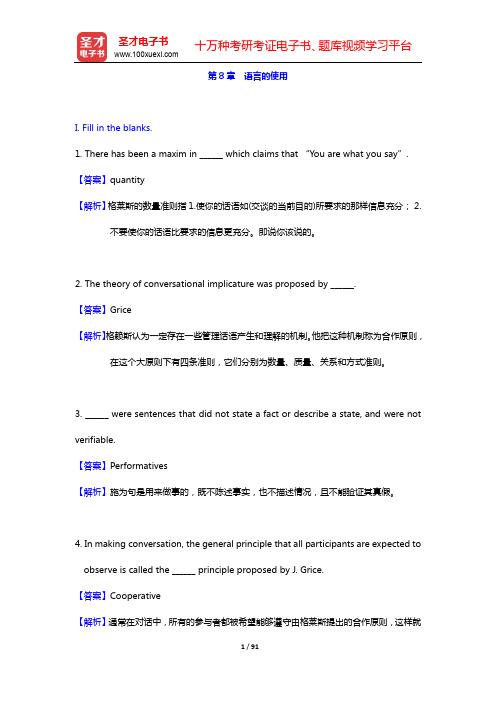
第8章语言的使用I. Fill in the blanks.1. There has been a maxim in ______ which claims that “You are what you say”. 【答案】quantity【解析】格莱斯的数量准则指1.使你的话语如(交谈的当前目的)所要求的那样信息充分;2.不要使你的话语比要求的信息更充分。
即说你该说的。
2. The theory of conversational implicature was proposed by ______.【答案】Grice【解析】格赖斯认为一定存在一些管理话语产生和理解的机制。
他把这种机制称为合作原则,在这个大原则下有四条准则,它们分别为数量、质量、关系和方式准则。
3. ______ were sentences that did not state a fact or describe a state, and were not verifiable.【答案】Performatives【解析】施为句是用来做事的,既不陈述事实,也不描述情况,且不能验证其真假。
4. In making conversation, the general principle that all participants are expected to observe is called the ______ principle proposed by J. Grice.【答案】Cooperative【解析】通常在对话中,所有的参与者都被希望能够遵守由格莱斯提出的合作原则,这样就不会有会话含义的产生。
5. In the light of the ______ principle, four maxims are specified.They are the maxim of quantity, maxim of ______, maxim of ______ and the maxim of _____.【答案】cooperative; quality; relation; manner【解析】考查合作原则及四条次则:数量准则、质量准则、关联准则、方式准则。
语言学教程胡壮麟(第四版) 第8章
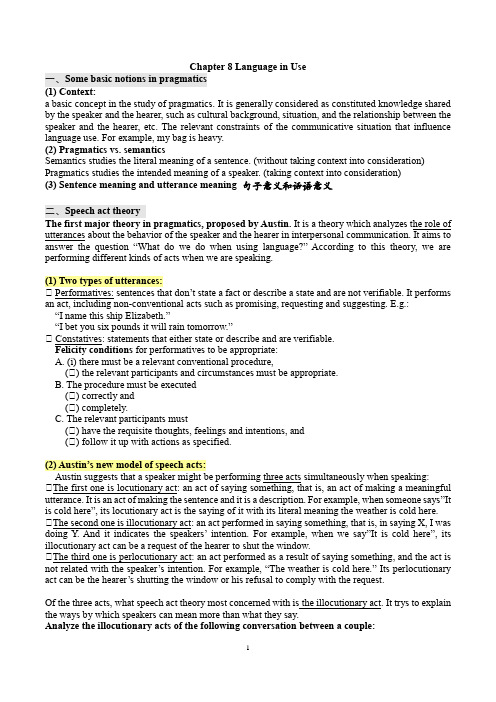
Chapter 8 Language in Use一、Some basic notions in pragmatics(1) Context:a basic concept in the study of pragmatics. It is generally considered as constituted knowledge shared by the speaker and the hearer, such as cultural background, situation, and the relationship between the speaker and the hearer, etc. The relevant constraints of the communicative situation that influence language use. For example, my bag is heavy.(2) Pragmatics vs. semanticsSemantics studies the literal meaning of a sentence. (without taking context into consideration) Pragmatics studies the intended meaning of a speaker. (taking context into consideration)(3) Sentence meaning and utterance meaning 句子意义和话语意义二、Speech act theoryThe first major theory in pragmatics, proposed by Austin. It is a theory which analyzes the role of utterances about the behavior of the speaker and the hearer in interpersonal communication. It aims to answer the question “What do we do when using language?” According to this theory, we are performing different kinds of acts when we are speaking.(1) Two types of utterances:① Performatives: sentences that don’t state a fact or describe a state and are not verifiable. It performs an act, including non-conventional acts such as promising, requesting and suggesting. E.g.:“I name this ship Elizabeth.”“I bet you six pounds it will rain tomorrow.”① Constatives: statements that either state or describe and are verifiable.Felicity conditions for performatives to be appropriate:A. (i) there must be a relevant conventional procedure,(①) the relevant participants and circumstances must be appropriate.B. The procedure must be executed(①) correctly and(①) completely.C. The relevant participants must(①) have the requisite thoughts, feelings and intentions, and(①) follow it up with actions as specified.(2) Austin’s new model of speech acts:Austin suggests that a speaker might be performing three acts simultaneously when speaking:①The first one is locutionary act: an act of saying something, that is, an act of making a meaningful utterance. It is an act of making the sentence and it is a description. For example, when someone says”It is cold here”, its locutionary act is the saying of it with its literal meaning the weather is cold here.①The second one is illocutionary act: an act performed in saying something, that is, in saying X, I was doing Y. And it indicates the speakers’ intention. For example, when we say”It is cold here”, its illocutionary act can be a request of the hearer to shut the window.①The third one is perlocutionary act: an act performed as a result of saying something, and the act is not related with the speaker’s intention. For example, “The weather is cold here.” Its perlocutionary act can be the hearer’s shutting the window or his refusal to comply with the request.Of the three acts, what speech act theory most concerned with is the illocutionary act. It trys to explain the ways by which speakers can mean more than what they say.Analyze the illocutionary acts of the following conversation between a couple:——— (the telephone rings)——— H: That’ the phone. (1)——— W: I’ m in the bathroom. (2)——— H: Okay. (3)This seemingly incoherent conversation goes on successfully because the speakers understand each other’s illocutionary acts:1) Asking his wife to go and answer the phone.2) A refusal to comply with the request; asking her husband to answer the phone instead.3) Accepting the wife’s refusal and accepting her request, meaning “all right, I’ll answer it.”(3) Searle’s classification of illocutionary acts:Searle has made great contribution to the development of the speech act theory. According to Searle, speech act are divided into five general categories. That is, five general types of things we do with language. Each type has a common, general purpose. They are representatives, directives, commsives, expressives, declarations. (阐述类、指令类、承诺类、表达类、宣告类)三、The theory of conversational implicature 会话含义理论The second major theory in pragmatics. Proposed by Grice.In daily communication, people are observing a set of basic rules of cooperating with each other so as to communicate effectively through conversation. He calls this set of rules the cooperative principle elaborated in four maxims.(1) Cooperative principle (CP)In making a conversation, all participants are expected to observe a general principle: Make your conversational contribution such as is required, at the stage at which it occurs, by the accepted purpose or direction of the talk exchange in which you are engaged.Four maxims of CP:1) The maxim of quantity1) Make your contribution as informative as is required (for the current purposes of the exchange).2) Do not make your contribution more informative than is required.2) The maxim of qualityTry to make your contribution one that is true.1) Do not say what you believe to be false.2) Do not say that for which you lack adequate evidence.3) The maxim of relationBe relevant.4) The maxim of mannerBe perspicuous.1) Avoid obscurity of expression.2) Avoid ambiguity.3) Be brief.4) Be orderly.(2) Conversational implicatureAccording to Grice, it refers to the extra meaning not contained in the utterance, but understandable to the listener. Only when he shares the speakers’ knowledge or he knows why and how, he violates intentionally one of the four maxims of CP.The following provides different circumstances of the violation of CP and its maxims.1) Violation of the maxim of quantityA:When is Lucy’s birthday party?B:Sometimes next month.A:Where is X?B:He’s gone to the library. He said so when he left.2) Violation of the Maxim of qualityHe is made of iron. (Metaphor)Every nice girl loves a sailor.3) Violation of the maxim of relationA: How do you like my painting?B: I’m afraid I don’t have any eye for beauty. A: What time is it?B: The postman has just arrived.4) Violation of the maxim of mannerA: Shall we get something for the kids?B: Yes. But I veto I-C-E-C-R-E-A-M.A:Where is your mother?B: She is either in the room or at the market. (3) Characteristics of implicature(4) Politeness Principle (PP)Leech suggests that CP can’t explain why people are often so indirect in conveying what they mean. Conversational interaction is a social behaviour. Choice of linguistic codes is central in language use. There are social and psychological factors that determined the choice.Besides being cooperative, participants try to be polite. And the speakers consider the matter of face for themself and others. Based on this observation, Leech proposed PP, which contains six maxims.1.Tact 策略Minimize cost to other.Maximize benefit to other.2.Generosity 宽宏Minimize benefit to self.Maximize cost to self.3.Approbation 赞扬Minimize dispraise of other.Maximize praise of other.4.Modesty 谦虚Minimize praise of self.Maximize dispraise of self.5.Agreement 赞同Minimize disagreement between self and other.Maximize agreement between self and other.6.Sympathy 同情Minimize antipathy between self and other.Maximize sympathy between self and other.四、Post-Gricean Developments3.Levinson’s Q- , I- and M- principles。
《语言学教程》 Chapter 8_pragmatics

8
Performatives
I do. I name this ship Queen Elizabeth. I bet you sixpence it will rain tomorrow. I give and bequeath my watch to my brother. I promise to finish it in time. I apologize. I declare the meeting open. I warn you that the bull will charge.
8.2 Speech Aቤተ መጻሕፍቲ ባይዱt Theory
John Austin (1911-1960) How to Do Things with Words (1962) Speech acts: actions performed via utterances 1. I got up very early this morning. 2. We are having a class on linguistics. 3. I’m sorry for making you bored. 4. Let’s go and have a drink. 1 and 2: verifiable constatives(述事话语) 3 and 4: unverifiable performatives(行事话语)
Key in the distinction
Both semantics and pragmatics study the meaning of a linguistic form. However, they are different in many respects, such as their research methods, their research scope. What essentially distinguishes them is whether in the study of meaning the context of use is considered. If it its not considered, the study is confined to the area of traditional semantics; If it is considered, the study is being carried out in the area of pragmatics. 5
语言学教程第8章
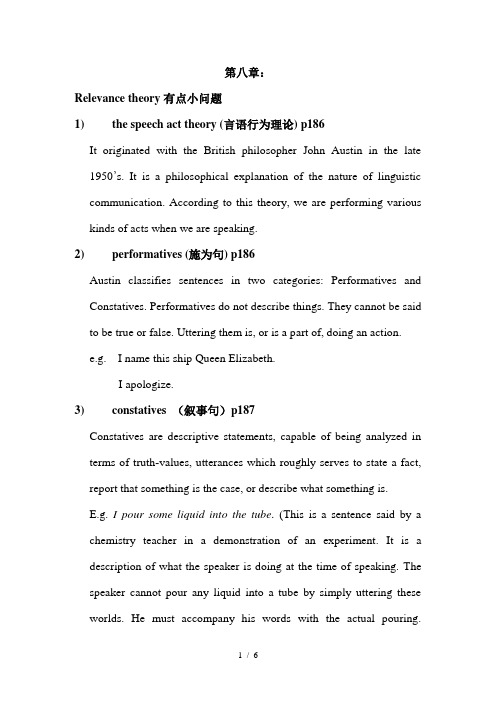
第八章:Relevance theory有点小问题1)the speech act theory (言语行为理论) p186It originated with the British philosopher John Austin in the late 1950’s. It is a philosophical explanation of the nature of linguistic communication. According to this theory, we are performing various kinds of acts when we are speaking.2)performatives (施为句) p186Austin classifies sentences in two categories: Performatives and Constatives. Performatives do not describe things. They cannot be said to be true or false. Uttering them is, or is a part of, doing an action.e.g. I name this ship Queen Elizabeth.I apologize.3)constatives (叙事句)p187Constatives are descriptive statements, capable of being analyzed in terms of truth-values, utterances which roughly serves to state a fact, report that something is the case, or describe what something is.E.g. I pour some liquid into the tube.(This is a sentence said by achemistry teacher in a demonstration of an experiment. It is a description of what the speaker is doing at the time of speaking. The speaker cannot pour any liquid into a tube by simply uttering these worlds. He must accompany his words with the actual pouring.Otherwise one can accuse him of making a false statement.)4)locutionary act (发话行为)p188utterance meaning (the movement of muscles)The act of producing speech sounds, words or sentences.(According to Austin, there are three senses in which saying something may be understood as doing something, one of them is ) locutionary act, which is the act of producing speech sounds, words or sentences or the act of saying something in the full sense of “say”.5)illocutionary act (行事行为)p189speaker’s meaning (intention)(the other sense is illocutionary act which means) the act of making known the speaker’s purpose or the intended meaning: asking or answering a question, giving some information or an assurance or a warning, pronouncing sentence, making a request or an appointment or a criticism, making identification or giving a description, and many others.6)perlocutionary act (取效行为)p189contextual meaning (results)(the third sense is) perlocutionary act which means the consequential effect of a locution upon the hearer. By saying something the speaker may change the opinion of the hearer, misleading him, surprising him, or inducing him to do something (the act preformed by or as a result ofsaying, the effects on the hearer.).7)the cooperative principle (合作原则)p191This is the principle suggested by Grice about the regularity in conversation. According to Grice, in daily conversations, people are cooperative. They often recognize a common purpose or a set of purposes or at least a mutually agreed direction for the conversation to develop. That is, they follow a cooperative principle or CP for short.The cooperative principle has four categories of maxims: maxims of quality, maxims of quantity, maxims of relation, and maxims of manner.8)maxim of quantity (数量准则)Be economicalmake your contribution as informative as is required (for the current purpose of the exchange) but do not make your contribution more informative than is required.9)maxim of quality (质量准则)Be truthfuldo not say what you believe to be false and do not say that for which you lack adequate evidence.10)maxim of relation (关系准则)Be relevant (what you say)11)maxim of manner (方式准则)Be clearBe perspicuous(清晰明白的). Avoid obscurity of expression. Avoid ambiguity. Be brief. And be orderly.12)calculability (可推导性or 可计算性)p195It is the first character of implicature. Implicature is calculable in that it can be worked out on the basis of previous information, including: 1) the conventional meaning of the words, 2) the CP and its maxims, 3) the context, 4) other items of the background knowledge, 5) the fact that all relevant items falling under the previous headings are available to both participants and both participants know or assume this to be the case. (Hearers work out implicature based on literal meaning, CP and its maxims, context, etc.)13)cancellability (可取消性)p196Also known as defeasibility(可废除性). A conversational implicature relies on a number of factors: the conventional meaning of words used, the CP, the linguistic and situational contexts, etc. If any of them changes, the implicature will also change.14)non-detachability (不可分离性)p196A conversational implicature is attached to the semantic content ofwhat is said, not to the linguistic form. Therefore it is possible to use a synonym and keep the implicature intact. In other words, an implicature will not be detached, separated from the utterance as awhole, even though the specific words may be changed.15)non-conventionality (非常规性)p197Implicature is different from its conventional meaning of words. It is context-dependent. It is indeterminate and varies with context.Conversational implicature is by definition different from the conventional meaning of words.16)contextual meaning (语境意义)(perlocutionary act)meaning in context, meaning made in different situationsThe meaning of the sentence depends on who the speaker is, who the hearer is, when and where it is used.17)pragmatics (语用学)The study of language in use. The study of meaning in context. The study of speakers’ meaning, utterance meaning, & contextual meaning.18) relevance theory (关联理论)p194Relevance theory was formally proposed by Sperber and Wilson in their book Relevance: Communication and Cognition in 1986. They argue that all Gricean maxims, including the CP itself should be reduced to a single principle of relevance, which is defined as:Every act of ostensive communication communicates the presumption of its optimal relevance.The assumption, or principle, underlying relevance theory is that in anygiven context, what people say is relevant. This principle of relevance can be seen as a further specification of the Gricean notion of cooperation. For relevance theory, achieving successful communication by way of the relevance of what is being said is a sufficient aim in conversation or other verbal interaction. RT is thus a minimalist theory of communication. Relevance is all we need.[文档可能无法思考全面,请浏览后下载,另外祝您生活愉快,工作顺利,万事如意!]。
语言学教程第二版第八章答案
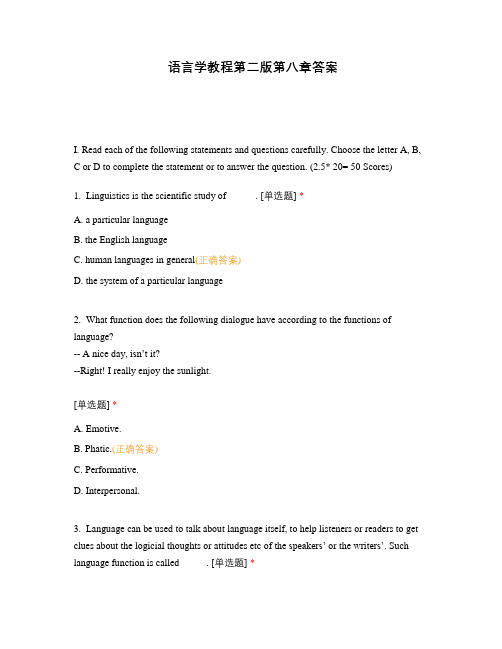
语言学教程第二版第八章答案I. Read each of the following statements and questions carefully. Choose the letter A, B, C or D to complete the statement or to answer the question. (2.5* 20= 50 Scores)1. Linguistics is the scientific study of______. [单选题] *A. a particular languageB. the English languageC. human languages in general(正确答案)D. the system of a particular language2. What function does the following dialogue have according to the functions of language?-- A nice day, isn’t it?--Right! I really enjoy the sunlight.[单选题] *A. Emotive.B. Phatic.(正确答案)C. Performative.D. Interpersonal.3. Language can be used to talk about language itself, to help listeners or readers to get clues about the logicial thoughts or attitudes etc of the speakers’ or the writers’. Such language function is called _____. [单选题] *A. phatic function.B. recreational function.C. emotive function.D. metalingual function.(正确答案)4. If a linguistic study describes and analyzes the language people actually use, it is said to be _______. [单选题] *A. prescriptiveB. analyticC. descriptive(正确答案)D. linguistic5. Saussure took a(n) _______ view of language, while Chomsky looks at language froma ________ point of view. [单选题] *A. sociological…psychological(正确答案)B. psychological…sociologicalC. applied…pragmaticD. semantic…linguistic6. Which is the branch of linguistics that studies the characteristics of speech sounds and provides methods for their description, classification and transcription? [单选题] *A. Phonetics(正确答案)B. PhonologyC. SemanticsD. Pragmatics7. The core branch of linguistics excludes ______. [单选题] *A. semanticsB. morphologyC. phoneticsD. psycholinguistics(正确答案)8. Of all the speech organs, the _____ is/are the most flexible. [单选题] *A. mouthB. lipsC. tongue(正确答案)D. vocal cords9. A _____ vowel is one that is produced with the front part of the tongue maintaining the highest position. [单选题] *A. backB. centralC. front(正确答案)D. middle10. Open vowels don’t contain _______. [单选题] *A. [i](正确答案)B. [a]C. [a:]D. [ɔ]11. The naming theory was put forward by _______. [单选题] *A. Plato(正确答案)B. ChomskyC. Ogden RichardD. Firth12. “Male”and" female"are _________. [单选题] *A. stylistic antonymsB. relational antonymsC. gradable antonymsD. complementary antonyms(正确答案)13. “Can I borrow your bike?”_________“You have a bike”. [单选题] *A. is synonymous withB. presupposes(正确答案)C. entailsD. is inconsistent with14. Modern linguistics regards the written language as ________. [单选题] *A. primaryB. correctC. secondary(正确答案)D. stable15. The core branch of linguistics excludes ______. [单选题] *A. semanticsB. morphologyC. phoneticsD. psycholinguistics(正确答案)16. According to Chomsky, which is the ideal user’s internalized knowledge of his language? [单选题] *A. Competence(正确答案)B. ParoleC. PerformanceD. Langue17. Unlike animal communication systems, human languag is _____. [单选题] *A. stimulus-free(正确答案)B. stimulus-drivenC. under immediate stimulus controlD. simulated by some occurrence of communal interest18. Among the three metafunctions of languages proposed by Halliday (1994), _____, the participatory function of langauge, enacts social relationships and textual function creates relevance to context. [单选题] *A. ideational function.B. interpersonal function.(正确答案)C. textual function.D. perfomative function19. Language can be used to refer to contexts removed from the immediate situations of the speaker. This feature is called _______. [单选题] *A. displacement(正确答案)B. dualityC. flexibilityD. cultural transmission20. The details of any language system is passed on from one generation to the next through _______, rather than by instinct. [单选题] *A. learningB. teachingC. booksD. both A and B(正确答案)II. Fill in the blank in each of the following statements with a word or words, the first letter of which is already given as a clue. (2.5* 20= 50 Scores)21. D_____ is one of the design features of human language which refers to the phenomenon that langauge consists of two levels: a lower level of meaningless individual sounds and a higher level of meaningful units. [填空题] *_________________________________(答案:uality)22. Language is p______ in that it makes possible the construction and interpretation of new signals by its users. In other words, they can produce and understand an infinitely large number of sentences which they have never heard before. [填空题] *_________________________________(答案:roductive)23. T______ function of language creates relevance to context and enables us to construct texts out of our utterances and writings. [填空题] *_________________________________(答案:extual)24. Chomsky defines “competence” as the ideal user’s k______of the rules of his language. [填空题] *_________________________________(答案:nowledge)25. Langue refers to the a______ linguistic system shared by all the members of a speech community while the parole is the concrete use of the conventions and application of the rules. [填空题] *_________________________________(答案:bstract)26. P_______ refers to the realization of langue in actual use. [填空题] *_________________________________(答案:arole)27. S_______ is the father of modern linguistics. [填空题] *_________________________________(答案:aussure)28. S________ is the study of the meaning of words and sentences. [填空题] *_________________________________(答案:emantics)29. Linguistic study in the 19th century was primarily about the d_______ studies. [填空题] *_________________________________(答案:iachronic)30. IPA indicates International Phonetics A______. [填空题] *_________________________________(答案:lphabet)31. A c_____ is a speech sound that is articulated with complete or partial closure of the vocal tract. [填空题] *_________________________________(答案:onsonant)32. E_______ is a relation of inclusion. [填空题] *_________________________________(答案:ntailment)33. "There"and"their" are h_______. [填空题] *_________________________________(答案:omophones)34. "Light"and"heavy are g_______ antonyms. [填空题] *_________________________________(答案:radable)35. I________ function of language enacts social relationships. [填空题] *_________________________________(答案:nterpersonal)36. The d_____ theory sees that the origin of language is from people’s response to the things around them by sounds. [填空题] *_________________________________(答案:ing-dong)37. Human capacity for language has a g________ basis, but the details of language have to be taught and learned. [填空题] *_________________________________(答案:enetic)38. C_______ analysis is based on the belief that the meaning of a word can be divided into meaning components. [填空题] *_________________________________(答案:omponential)39. P______ function of language can be used to maintain comfortable social relationship between speakers. [填空题] *_________________________________(答案:hatic)40. Lanauge is v________ as the primary medium for all languges is sound. [填空题] * _________________________________(答案:ocal)。
胡壮麟《语言学教程》笔记和考研真题及典型题详解(语言的使用)【圣才出品】
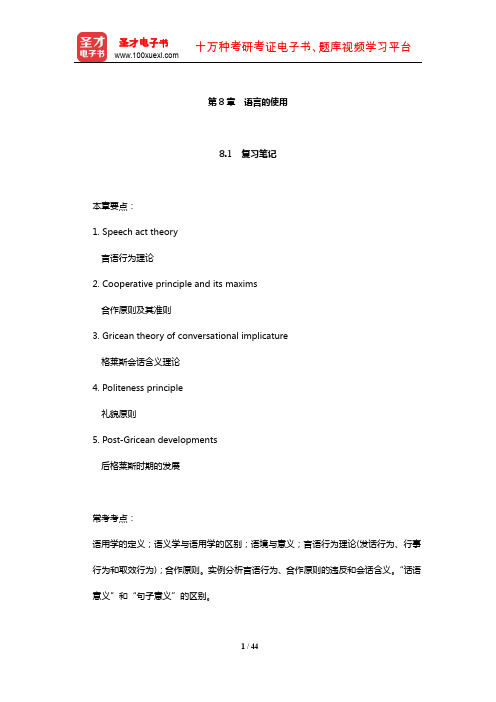
第8章语言的使用8.1 复习笔记本章要点:1. Speech act theory言语行为理论2. Cooperative principle and its maxims合作原则及其准则3. Gricean theory of conversational implicature格莱斯会话含义理论4. Politeness principle礼貌原则5. Post-Gricean developments后格莱斯时期的发展常考考点:语用学的定义;语义学与语用学的区别;语境与意义;言语行为理论(发话行为、行事行为和取效行为);合作原则。
实例分析言语行为、合作原则的违反和会话含义。
“话语意义”和“句子意义”的区别。
本章内容索引:I. Pragmatics1. Definition2. Difference between pragmatics and semantics II. Speech Act Theory1. Performatives and Constatives(1) Definition(2) Felicity Conditions2. A Theory of the Illocutionary Act3. Searle’s Classification of Speech Acts(1) Representatives:(2) Directives(3) Commsives(4) Expressives(5) DeclarationsIII. Cooperative Principle (CP)1. Cooperative Principle and Its Maxims2. Violation of the MaximsIV. Conversational Implicature1. Definition2. Characteristics of Conversational Implicature(1) Calculability.(2) Cancellability(3) Non-detachability(4) Non-conventionality.V. Politeness Principle (PP)VI. Post-Gricean Developments1. Relevance Theory2. The Q- and R-principles3. Levinson’s Q-, I-and M-principles▼4. A socio-cognitive approachI. Pragmatics (语用学)【考点:Pragmatics与Semantics的异同】1. Definition (定义)Pragmatics is the study of language in use, focusing on the study of speaker’s meaning, utterance meaning or contextual meaning.语用学是研究语言实际运用的学科,集中研究说话人意义、话语意义或语境意义。
刘润清《新编语言学教程》章节题库-第八章至第十二章【圣才出品】
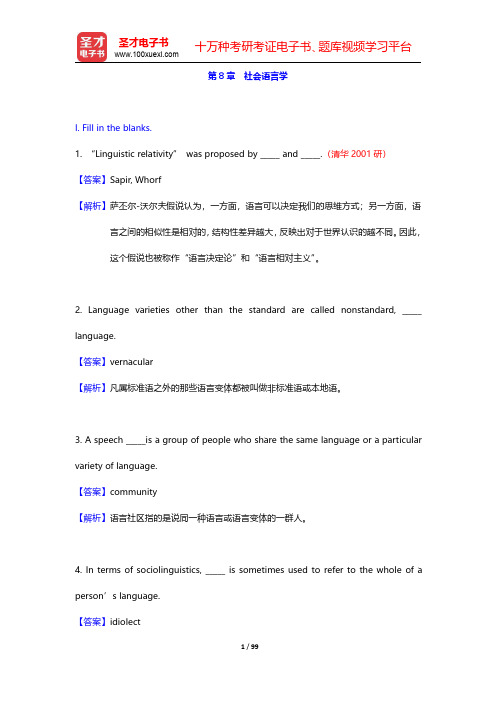
第8章社会语言学I.Fill in the blanks.1.“Linguistic relativity”was proposed by_____and_____.(清华2001研)【答案】Sapir,Whorf【解析】萨丕尔-沃尔夫假说认为,一方面,语言可以决定我们的思维方式;另一方面,语言之间的相似性是相对的,结构性差异越大,反映出对于世界认识的越不同。
因此,这个假说也被称作“语言决定论”和“语言相对主义”。
nguage varieties other than the standard are called nonstandard,_____ language.【答案】vernacular【解析】凡属标准语之外的那些语言变体都被叫做非标准语或本地语。
3.A speech_____is a group of people who share the same language or a particular variety of language.【答案】community【解析】语言社区指的是说同一种语言或语言变体的一群人。
4.In terms of sociolinguistics,_____is sometimes used to refer to the whole of a person’s language.【答案】idiolect【解析】从社会语言学的角度讲,个人习语指个人语言风格。
5.In many societies of the world,we find a large number of people who speak more than one language.As a characteristic of societies,_____inevitably results from the coming into contact of people with different cultures and different languages.【答案】bilingualism【解析】双语现象源于不同文化和不同语言相互交流的结果。
语言学 第八章PPT课件

It takes place in the speech community where one's first lge or SL is spoken. It is often natural, without much focus on form.
❖a complicated process, involving a wide range of social, psychological, cognitive, linguistic, physiological factors.文 秋 芳教 授来自吴 一 安教 授
❖ 高一虹教授
❖ (英)
❖ Chomsky
Anderson
❖ krashen
戴 炜 栋
教 授
❖ 刘润清教授
❖ Rod Ellis
a Professor in the Department of Applied language studies and Linguistics at University of Auckland, New Zealand
1) there is no formal instruction in FLA.
2) Children all over the world go through the same stage in LA.
先天论:
代表人物: 乔姆斯基、 卡茨,心理学家米 勒与马克奈尔。
主要观点:1)是一种基于对刺激—反应论猛烈 批判立场上建立起的理论,是基于理性主义的理 论。语言是一种规则体系,是一种以规则为基 础的复杂系统而并非习惯的总和,儿童之所以 能掌握,是因为人类有天生的、具有受遗传因 素决定的掌握语言规则的能力,即“语言能 力”。乔姆斯基还提出了“语言运用”的概念, 即说话人和听话人对语言规则的具体运用(言 语活动)。语言运用以语言能力为基础。
语言学教程 第三版 第八章 语用学
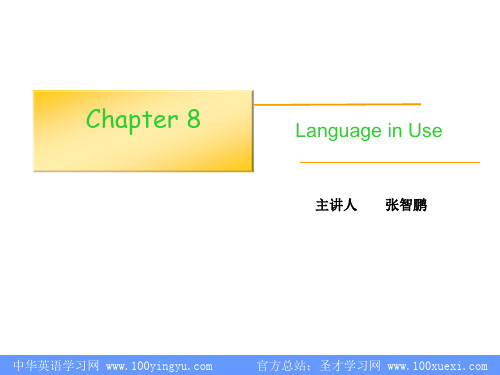
官方总站:圣才学习网
8.1.2 A Theory of the Illocutionary Act
Speech acts can be analyzed on 3 levels: ■A locutionary act(发话行为/言内行为): the act of saying something in the full sense of “say”. ■An illocutionary act(行事行为/言外行为): an act performed in saying something. To say sth is to do sth.
■Conclusion: ■The distinction between constatives & performatives cannot be maintained. ■All sentences can be used to do things.
中华英语学习网
■In saying X, I was doing Y. ■In saying “I will come tomorrow”, I was making a promise. ■Illocutionary force: equivalent to speaker's meaning, contextual meaning, or extra meaning, and may be
■John Austin (1911-1960) ■How to Do Things with Words (1962) ■speech acts: actions performed via utterances
8.1.1 Performatives vs. Constatives(施为句与叙事句) ■Constatives: utterances which roughly serves to state a fact, report that something is the case, or describe
- 1、下载文档前请自行甄别文档内容的完整性,平台不提供额外的编辑、内容补充、找答案等附加服务。
- 2、"仅部分预览"的文档,不可在线预览部分如存在完整性等问题,可反馈申请退款(可完整预览的文档不适用该条件!)。
- 3、如文档侵犯您的权益,请联系客服反馈,我们会尽快为您处理(人工客服工作时间:9:00-18:30)。
第八章:Relevance theory有点小问题1)the speech act theory (言语行为理论) p186It originated with the British philosopher John Austin in the late 1950’s. It is a philosophical explanation of the nature of linguistic communication. According to this theory, we are performing various kinds of acts when we are speaking.2)performatives (施为句) p186Austin classifies sentences in two categories: Performatives and Constatives. Performatives do not describe things. They cannot be said to be true or false. Uttering them is, or is a part of, doing an action.e.g. I name this ship Queen Elizabeth.I apologize.3)constatives (叙事句)p187Constatives are descriptive statements, capable of being analyzed in terms of truth-values, utterances which roughly serves to state a fact, report that something is the case, or describe what something is.E.g. I pour some liquid into the tube.(This is a sentence said by achemistry teacher in a demonstration of an experiment. It is a description of what the speaker is doing at the time of speaking. The speaker cannot pour any liquid into a tube by simply uttering these worlds. He must accompany his words with the actual pouring.Otherwise one can accuse him of making a false statement.)4)locutionary act (发话行为)p188utterance meaning (the movement of muscles)The act of producing speech sounds, words or sentences.(According to Austin, there are three senses in which saying something may be understood as doing something, one of them is ) locutionary act, which is the act of producing speech sounds, words or sentences or the act of saying something in the full sense of “say”.5)illocutionary act (行事行为)p189speaker’s meaning (intention)(the other sense is illocutionary act which means) the act of making known the speaker’s purpose or the intended meaning: asking or answering a question, giving some information or an assurance or a warning, pronouncing sentence, making a request or an appointment or a criticism, making identification or giving a description, and many others.6)perlocutionary act (取效行为)p189contextual meaning (results)(the third sense is) perlocutionary act which means the consequential effect of a locution upon the hearer. By saying something the speaker may change the opinion of the hearer, misleading him, surprising him, or inducing him to do something (the act preformed by or as a resultof saying, the effects on the hearer.).7)the cooperative principle (合作原则)p191This is the principle suggested by Grice about the regularity in conversation. According to Grice, in daily conversations, people are cooperative. They often recognize a common purpose or a set of purposes or at least a mutually agreed direction for the conversation to develop. That is, they follow a cooperative principle or CP for short.The cooperative principle has four categories of maxims: maxims of quality, maxims of quantity, maxims of relation, and maxims of manner.8)maxim of quantity (数量准则)Be economicalmake your contribution as informative as is required (for the current purpose of the exchange) but do not make your contribution more informative than is required.9)maxim of quality (质量准则)Be truthfuldo not say what you believe to be false and do not say that for which you lack adequate evidence.10)maxim of relation (关系准则)Be relevant (what you say)11)maxim of manner (方式准则)Be clearBe perspicuous(清晰明白的). Avoid obscurity of expression. Avoid ambiguity. Be brief. And be orderly.12)calculability (可推导性or 可计算性)p195It is the first character of implicature. Implicature is calculable in that it can be worked out on the basis of previous information, including: 1) the conventional meaning of the words, 2) the CP and its maxims, 3) the context, 4) other items of the background knowledge, 5) the fact that all relevant items falling under the previous headings are available to both participants and both participants know or assume this to be the case. (Hearers work out implicature based on literal meaning, CP and its maxims, context, etc.)13)cancellability (可取消性)p196Also known as defeasibility(可废除性). A conversational implicature relies on a number of factors: the conventional meaning of words used, the CP, the linguistic and situational contexts, etc. If any of them changes, the implicature will also change.14)non-detachability (不可分离性)p196A conversational implicature is attached to the semantic content ofwhat is said, not to the linguistic form. Therefore it is possible to use a synonym and keep the implicature intact. In other words, an implicature will not be detached, separated from the utterance as awhole, even though the specific words may be changed.15)non-conventionality (非常规性)p197Implicature is different from its conventional meaning of words. It is context-dependent. It is indeterminate and varies with context.Conversational implicature is by definition different from the conventional meaning of words.16)contextual meaning (语境意义)(perlocutionary act)meaning in context, meaning made in different situationsThe meaning of the sentence depends on who the speaker is, who the hearer is, when and where it is used.17)pragmatics (语用学)The study of language in use. The study of meaning in context. The study of speakers’ meaning, utterance meaning, & contextu al meaning.18) relevance theory (关联理论)p194Relevance theory was formally proposed by Sperber and Wilson in their book Relevance: Communication and Cognition in 1986. They argue that all Gricean maxims, including the CP itself should be reduced to a single principle of relevance, which is defined as:Every act of ostensive communication communicates the presumption of its optimal relevance.The assumption, or principle, underlying relevance theory is that in anygiven context, what people say is relevant. This principle of relevance can be seen as a further specification of the Gricean notion of cooperation. For relevance theory, achieving successful communication by way of the relevance of what is being said is a sufficient aim in conversation or other verbal interaction. RT is thus a minimalist theory of communication. Relevance is all we need.。
